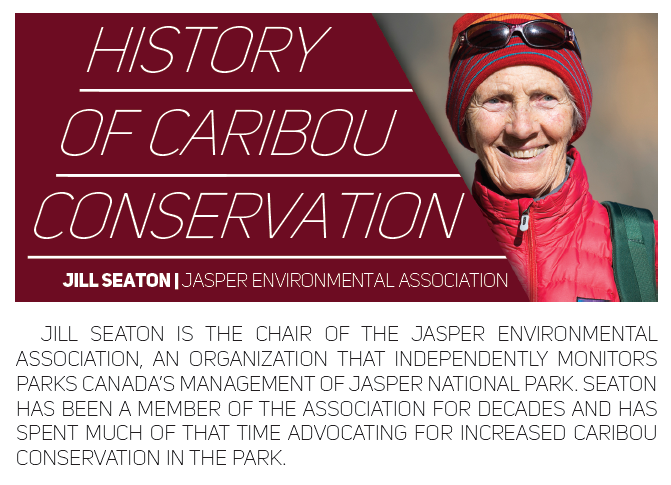 The Jasper Environmental Association (JEA) sympathizes with Parks CanadaÔÇÖs present field staff, which is faced with an uphill struggle to save one of CanadaÔÇÖs most iconic species. They are bearing the brunt of 40 years of inaction by past senior staff and successive uninterested federal governments to save a rapidly declining population of threatened woodland caribou from potential extinction.
The Jasper Environmental Association (JEA) sympathizes with Parks CanadaÔÇÖs present field staff, which is faced with an uphill struggle to save one of CanadaÔÇÖs most iconic species. They are bearing the brunt of 40 years of inaction by past senior staff and successive uninterested federal governments to save a rapidly declining population of threatened woodland caribou from potential extinction.
There were ample warnings in the 1970s and 80s from park wardens and the Canadian Wildlife Service that caribou numbers were declining, but Parks delayed taking any precautionary action and commissioned three studies (Stelfox, 1974; Brown, 1994; Thomas, 1996). All three made strong observations and recommendations regarding human use in caribou habitat, but Parks took little action.
In 1992, the JEA urged Parks Canada to establish two caribou conservation areas in the habitat of the Tonquin and Maligne herds. It recommended they be under special management that would ensure human use would not adversely affect the caribou. Because research had shown wolves were using the ploughed Maligne Road to access caribou habitat, the JEA asked that the road be designated as a ÔÇťlow-maintenance roadÔÇŁ during the winter months and the use of salt, which attracts the caribou to the road, be eliminated. Parks did nothing.
Finally, 10 years later, in 2002, Jasper park management proposed an experimental closure of the Maligne Road in winter. Opposition was virulent in Jasper and Ottawa. Jasper staff retreated, citing the 2000 Jasper National Park Management Plan that said: ÔÇťKeep the Maligne Road open in winter for people who want to observe wildlife, ski or participate in other appropriate activities.ÔÇŁ Caribou recovery remained at square one.
Hopes were raised when the Species at Risk Act (SARA) became law in December 2002, stating: ÔÇťCanadaÔÇÖs protected areas, especially national parks, are vital to the protection and recovery of species at risk.ÔÇŁ Since then the environmental law firm, Ecojustice, has pointed out: ÔÇťOn paper, SARA is a good law thatÔÇöif implemented to its fullest extentÔÇöhas the potential to help endangered species survive and recover. In practice though, the federal governmentÔÇÖs implementation efforts have been characterized by chronic delays in producing recovery strategies, identifying critical habitat and protecting that habitat once it has been identified.ÔÇŁ
In 2004, Parks management started to take some action. Literature indicates that wolves will generally avoid deep snow but will take advantage of man-made tracks such as snowmobile and ski tracks. Parks assembled a committee of local ÔÇťstakeholdersÔÇŁ to come up with a recovery plan. Some of the committeeÔÇÖs ideas were adopted, but the result was judged to be ÔÇťtimidÔÇŁ by an independent expert commissioned by the Sierra Club of Canada. This judgment was not surprising: too many members of the committee were reluctant to recommend steps that would adversely affect business and recreation.
However, in 2005 tracksetting of ski trails in some caribou habitat was discontinued and dogs were banned from the same areas. In 2009, Parks closed the Cavell Road into important winter habitat until Feb. 15th, when it reasoned the snow would be hard enough to bear the weight of wolves anyway. This also applied to some other access routes into the Tonquin Valley and in 2013 winter access was delayed until Feb. 28th in the A La Peche range in the north of the park and some parts of the Brazeau range in the south.
Environment Canada is the ÔÇťresponsible authorityÔÇŁ for producing a recovery strategy for threatened and endangered species. It avoided this responsibility for more than six years until a coalition of five environmental groups took it to court in early 2014 and forced it to produce a strategy to save the Southern Mountain Woodland Caribou and three other species. Parks management in Jasper finally got the backing it needed to implement steps to try to save this population.
Parks took those steps on Dec. 22ÔÇödelaying access to Whistlers Creek and the whole of the Maligne herdÔÇÖs habitat west of the Maligne Road and east of Highway 93, as far south as the Icefields.
But, the fact that both these areas will be open to the public again at the end of FebruaryÔÇöno matter what the snow conditions areÔÇöindicates that orders from head office are still focused on protecting business interests rather than the caribou.
The Maligne herd is the only herd that remains in a national park year round. With the ongoing lack of protection for caribou in Alberta and British Columbia, this small herd of the Southern Mountain Woodland Caribou could one day be the last flickering light between its historical thousands and extinction.
Are we prepared to let that light blink out?
Jill Seaton
Special to the 51░Á═°
To read what backcountry users have to say about the delayed winter access to the Maligne and Whistlers valleys, check out .
For an overview of Parks Canada's recent decision, as well as perspective from Jasper's acting superintendent Alan Fehr, check out 
Also check out our story on .
